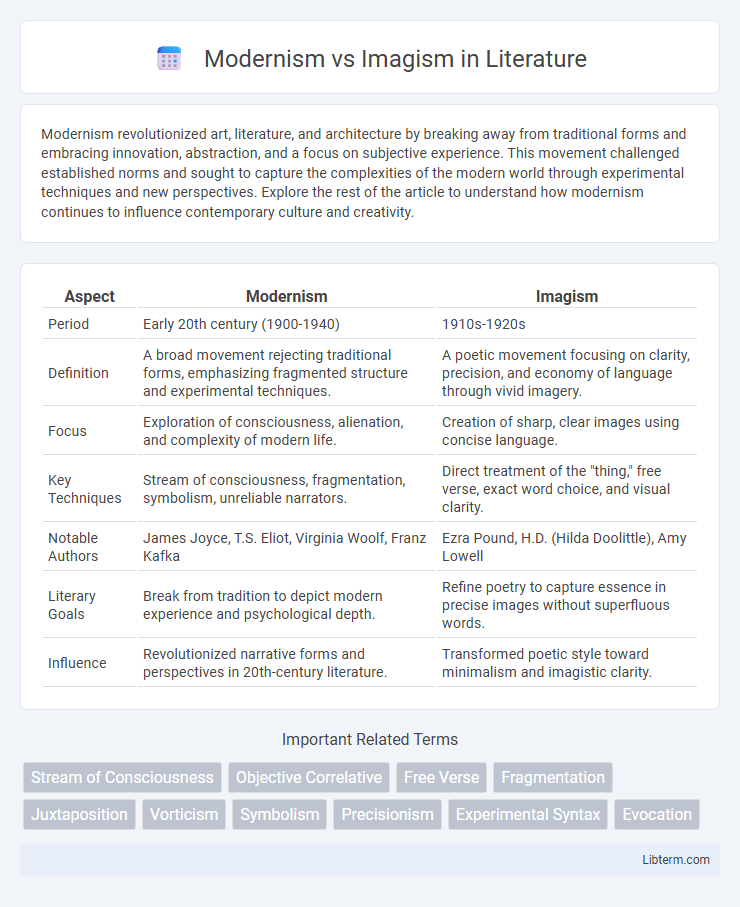Modernism revolutionized art, literature, and architecture by breaking away from traditional forms and embracing innovation, abstraction, and a focus on subjective experience. This movement challenged established norms and sought to capture the complexities of the modern world through experimental techniques and new perspectives. Explore the rest of the article to understand how modernism continues to influence contemporary culture and creativity.
Table of Comparison
| Aspect | Modernism | Imagism |
|---|---|---|
| Period | Early 20th century (1900-1940) | 1910s-1920s |
| Definition | A broad movement rejecting traditional forms, emphasizing fragmented structure and experimental techniques. | A poetic movement focusing on clarity, precision, and economy of language through vivid imagery. |
| Focus | Exploration of consciousness, alienation, and complexity of modern life. | Creation of sharp, clear images using concise language. |
| Key Techniques | Stream of consciousness, fragmentation, symbolism, unreliable narrators. | Direct treatment of the "thing," free verse, exact word choice, and visual clarity. |
| Notable Authors | James Joyce, T.S. Eliot, Virginia Woolf, Franz Kafka | Ezra Pound, H.D. (Hilda Doolittle), Amy Lowell |
| Literary Goals | Break from tradition to depict modern experience and psychological depth. | Refine poetry to capture essence in precise images without superfluous words. |
| Influence | Revolutionized narrative forms and perspectives in 20th-century literature. | Transformed poetic style toward minimalism and imagistic clarity. |
Introduction to Modernism and Imagism
Modernism, emerging in the early 20th century, revolutionized literature by emphasizing fragmented forms, subjective perspectives, and experimentation with language to capture the complexities of modern life. Imagism, a subset of Modernism led by poets like Ezra Pound and H.D., concentrated on clarity, precision, and the economy of language, promoting vivid, concrete imagery over abstract description. Both movements challenged traditional poetic conventions, with Modernism encompassing broader stylistic innovations and Imagism focusing specifically on sharpening visual expression and directness.
Historical Context and Origins
Modernism emerged in the late 19th and early 20th centuries as a response to rapid industrialization, urbanization, and World War I, emphasizing a break from traditional literary forms and experimentation with new styles. Imagism, a subset of Modernism founded by poets like Ezra Pound and H.D. around 1912, advocated for clear, precise imagery and concise language, reacting against the vagueness of Victorian poetry. Both movements reflect early 20th-century cultural shifts but differ in scope, with Modernism encompassing broader artistic innovations and Imagism focusing specifically on poetic brevity and sensory clarity.
Defining Characteristics of Modernism
Modernism is defined by its break from traditional forms, embracing experimental techniques and fragmented narrative structures to reflect the complexities of the 20th century. It often explores themes of alienation, disillusionment, and subjective reality, employing stream of consciousness and nonlinear timelines. Imagism, a subset of Modernism, emphasizes precision of imagery, clear and sharp language, and economy of words, contrasting with broader Modernist tendencies toward abstraction and ambiguity.
Defining Principles of Imagism
Imagism centers on clear, precise, and concise language that captures vivid sensory images, rejecting the elaborate verbosity of Modernism. Its defining principles emphasize direct treatment of the subject, economy of language, and the use of free verse to create sharp, clear pictures in the reader's mind. Unlike the often complex and abstract themes of Modernism, Imagism insists on concrete imagery and simplicity to evoke emotion and meaning immediately.
Key Figures in Modernism and Imagism
Key figures in Modernism include T.S. Eliot, Virginia Woolf, and James Joyce, whose works emphasized fragmented narratives and stream-of-consciousness techniques. Imagism, a subset of Modernism, was spearheaded by poets like Ezra Pound, H.D. (Hilda Doolittle), and Amy Lowell, focusing on clarity, precision, and vivid imagery. These poets rejected traditional meter and rhyme, prioritizing concise, direct expression and visual detail in their poetry.
Stylistic Differences: Structure and Language
Modernism emphasizes fragmented structures and complex narratives to reflect the chaos of the modern world, often employing stream of consciousness and multiple perspectives. Imagism prioritizes clarity and precision through concise, free verse poetry that uses direct language and sharp, vivid imagery to evoke specific moments or emotions. Whereas Modernist language can be abstract and layered, Imagist diction is minimalist and concrete, aiming for immediate sensory impact.
Thematic Focus and Subject Matter
Modernism explores themes of alienation, fragmentation, and the complexities of the human psyche, often delving into urban life and social change. Imagism emphasizes clarity, precision, and direct treatment of the "thing," focusing on concrete images and sensory detail rather than abstract ideas. While Modernism captures broad existential concerns, Imagism narrows its subject matter to vivid, sharply defined moments and objects.
Notable Works and Exemplary Texts
Modernism boasts notable works such as T.S. Eliot's "The Waste Land" and James Joyce's "Ulysses," which exemplify complex narrative structures and fragmented forms. Imagism, a subset of Modernism, is epitomized by Ezra Pound's "In a Station of the Metro" and H.D.'s "Oread," emphasizing clarity, precision, and vivid imagery. These exemplary texts highlight the contrast between Modernism's broader experimental scope and Imagism's concentrated focus on crisp, concrete images.
Influence on Contemporary Poetry
Modernism and Imagism significantly shaped contemporary poetry by emphasizing clarity, precision, and a break from traditional forms. Modernism introduced fragmented structures and deep psychological themes, expanding poetic expression, while Imagism prioritized vivid imagery and economy of language, influencing minimalist and visual poetry styles. Their combined impact fosters innovation in voice and form, inspiring poets to explore new ways of conveying complex emotions and ideas succinctly.
Lasting Impact and Critical Reception
Modernism revolutionized literary expression by embracing fragmentation, stream of consciousness, and abstract themes, profoundly influencing 20th-century literature and art. Imagism, a key Modernist offshoot led by Ezra Pound and H.D., prioritized clarity, precision, and vivid imagery, significantly shaping poetic form and inspiring subsequent movements like Symbolism and Minimalism. Critical reception of Modernism recognizes its groundbreaking redefinition of narrative and aesthetics, while Imagism is celebrated for its concise imagery and lasting contribution to modern poetry's evolution.
Modernism Infographic

 libterm.com
libterm.com